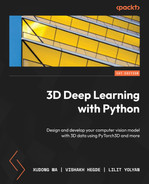Visualize and build deep learning models with 3D data using PyTorch3D and other Python frameworks to conquer real-world application challenges with ease With this hands-on guide to 3D deep learning, developers working with 3D computer vision will be able to put their knowledge to work and get up and running in no time. Complete with step-by-step explanations of essential concepts and practical examples, this book lets you explore and gain a thorough understanding of state-of-the-art 3D deep learning. You'll see how to use PyTorch3D for basic 3D mesh and point cloud data processing, including loading and saving ply and obj files, projecting 3D points into camera coordination using perspective camera models or orthographic camera models, rendering point clouds and meshes to images, and much more. As you implement some of the latest 3D deep learning algorithms, such as differential rendering, Nerf, synsin, and mesh RCNN, you'll realize how coding for these deep learning models becomes easier using the PyTorch3D library. By the end of this deep learning book, you'll be ready to implement your own 3D deep learning models confidently. This book is for beginner to intermediate-level machine learning practitioners, data scientists, ML engineers, and DL engineers who are looking to become well-versed with computer vision techniques using 3D data.Key Features
Book Description
What you will learn
Who this book is for
Table of Contents
- 3D Deep Learning with Python
- Contributors
- About the author
- About the reviewer
- Preface
- PART 1: 3D Data Processing Basics
- Chapter 1: Introducing 3D Data Processing
- Chapter 2: Introducing 3D Computer Vision and Geometry
- PART 2: 3D Deep Learning Using PyTorch3D
- Chapter 3: Fitting Deformable Mesh Models to Raw Point Clouds
- Chapter 4: Learning Object Pose Detection and Tracking by Differentiable Rendering
- Chapter 5: Understanding Differentiable Volumetric Rendering
- Chapter 6: Exploring Neural Radiance Fields (NeRF)
- PART 3: State-of-the-art 3D Deep Learning Using PyTorch3D
- Chapter 7: Exploring Controllable Neural Feature Fields
- Chapter 8: Modeling the Human Body in 3D
- Chapter 9: Performing End-to-End View Synthesis with SynSin
- Chapter 10: Mesh R-CNN
- Index
- Other Books You May Enjoy
